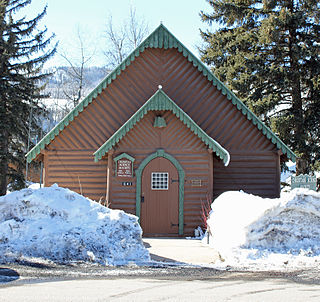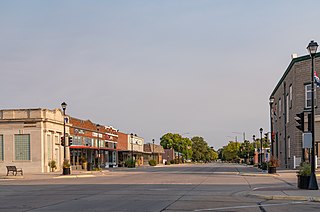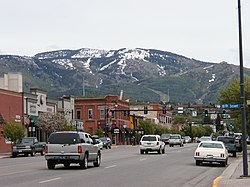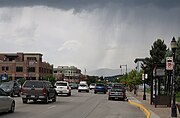
The Old Jeffersonville Historic District is located in Jeffersonville, Indiana, United States. It marks the original boundaries of Jeffersonville, and is the heart of modern-day downtown Jeffersonville. It was placed on the National Register of Historic Places in 1983. The area is roughly bounded by Court Avenue at the North, Graham Street on the east, the Ohio River at the south, and Interstate 65 at the west. In total, the district has 203 acres (0.8 km2), 500 buildings, 6 structures, and 11 objects. Several banks are located in the historic buildings in the district. The now defunct Steamboat Days Festival, held on the second weekend in September, used to be held on Spring Street and the waterfront. Jeffersonville's largest fire wiped out a block in the historic district on January 11, 2004 which destroyed the original Horner's Novelty store.

Victor Downtown Historical District is a 22 acres (8.9 ha) historic district encompassing several blocks of Victor, Colorado which was listed in the National Register of Historic Places in 1985. The listing included 55 contributing buildings out of 66 buildings in total. The district is bounded roughly by Diamond Avenue, Second, Portland and Fifth Streets.

The Clematis Street Historic Commercial District is a U.S. historic district located in West Palm Beach, Florida. The district runs along the 500 Block of Clematis Street. It contains 12 historic buildings.

The Downtown Albany Historic District is a 19-block, 66.6-acre (27.0 ha) area of Albany, New York, United States, centered on the junction of State and North and South Pearl streets. It is the oldest settled area of the city, originally planned and settled in the 17th century, and the nucleus of its later development and expansion. In 1980 it was designated a historic district by the city and then listed on the National Register of Historic Places.

There are nine historic districts in Meridian, Mississippi. Each of these districts is listed on the National Register of Historic Places. One district, Meridian Downtown Historic District, is a combination of two older districts, Meridian Urban Center Historic District and Union Station Historic District. Many architectural styles are present in the districts, most from the late 19th century and early 20th century, including Queen Anne, Colonial Revival, Italianate, Art Deco, Late Victorian, and Bungalow.

The Greenwich Avenue Historic District is a historic district representing the commercial and civic historical development of the downtown area of the town of Greenwich, Connecticut. The district was listed on the National Register of Historic Places on August 31, 1989. Included in the district is the Greenwich Municipal Center Historic District, which was listed on the National Register the year before for the classical revival style municipal buildings in the core of Downtown. Most of the commercial buildings in the district fall into three broad styles, reflecting the period in which they were built: Italianate, Georgian Revival, and Commercial style. The district is linear and runs north–south along the entire length of Greenwich Avenue, the main thoroughfare of Downtown Greenwich, between U.S. Route 1 and the New Haven Line railroad tracks.

Christian Science Society, also known as Christian Science Society Building, is an historic Christian Science church building located at 641 Oak Street corner of 7th Street in Steamboat Springs, Routt County, Colorado; Built in 1934 of logs on a rubble rock foundation with a shingle roof, it was designed and constructed by local builder Ernest Campbell in the style of architecture that has come to be known as the Rustic style. The society was organized on July 22, 1908, by local Christian Scientists, notable among whom was Margaret Crawford, who with her husband, James Crawford, had founded and named Steamboat Springs in 1875. It met at various local sites until November 4, 1934 when the first service was held in its new building. The building site purchased in 1920 had formerly been occupied by the Onyx Hotel. Christian Science churches and societies are no dedicated until they are free of debt and the Steamboat Springs society was dedicated on December 15, 1935. Regular services have been held ever since. The only significant changes in the building since 1934 have been replacing the roof with a metal one to allow snow to slide off and dropping the interior ceiling for better insulation. The side walls have also been stabilized by running several metal rods between them. On August 22, 2007, the building was added to the National Register of Historic Places.

The San Marco is a historic Renaissance Revival apartment building in Downtown, Spokane, Washington that was built in 1904. It was designed by architect Albert Held. San Marco was listed on the U.S. National Register of Historic Places in 1987. It is also listed on the NRHP as a contributing property in the Riverside Avenue Historic District.

The Crawford House is a building in Steamboat Springs, Colorado, USA, that is listed on the National Register of Historic Places for its importance as the primary residence for 36 years of James Harvey Crawford, the Father of Steamboat Springs, and his wife, Margaret Emerine (Bourn) Crawford, the Mother of Routt County. The two of them together were among the most influential pioneering families in northwest Colorado. The Crawford House is also listed as a rare local example of residential Romanesque Revival architecture.

The Chamber of Commerce Building in Steamboat Springs, Colorado, at 1201 Lincoln Ave., is a Modern Movement-style building that was designed by architect Eugene D. Sternberg and was built in 1960. Its 2009 application for NRHP listing describes it as "an unusual application of the Usonian housing style to a commercial building. It has an inverted gable roof which gives rise to it being known locally as the butterfly building. The roof accommodates cottonwood tree trunks growing through a hole in its overhang.

The Opelousas Historic District, in Opelousas in St. Landry Parish, Louisiana is a historic district which was listed on the National Register of Historic Places in 1989.

The Downtown Essex Junction Commercial Historic District encompasses the historically railroad-dominated portion of downtown Essex Junction, Vermont. Aligned along the south side of Railroad Avenue and adjacent portions of Main Street, the area underwent most of its development between 1900 and 1940, when Essex Junction served as a major regional railroad hub. The district was listed on the National Register of Historic Places in 2004.

The Lagrange Commercial Historic District in LaGrange, Georgia is a 32-acre (13 ha) historic district listed on the National Register of Historic Places. It includes 72 contributing buildings, two contributing sites, and 30 non-contributing buildings.

The Twin City Historic District in Twin City in Emanuel County, Georgia is a historic district which was listed on the National Register of Historic Places in 2014.

Columbine or Columbine Gold Camp at 8,697 feet (2,651 m) elevation in Routt County, Colorado, United States, ) is a former community gold mining community, now a unincorporated community, historic district, and a rental cabin resort. It dates from around 1895. It was listed as a historic district on the National Register of Historic Places in 2007.

The Columbia Historic District is a neighborhood in Cedarburg, Wisconsin, that is listed on the National Register of Historic Places. At the time the district was listed on the register, its contributing properties included 128 historic homes, one church, and eighty-seven historic outbuildings, including garages and barns, all constructed between 1844 and 1938. The district also contained several dozen building that were not considered to contribute to the historic district, including modern homes from the post-war era as well as modern garages and other additions to historic properties.

The Downtown Loveland Historic District in Loveland, Colorado is an 18 acres (7.3 ha) historic district which was listed on the National Register of Historic Places in 2015. It includes Loveland's commercial center which began in 1877, developed first as a railroad town, and then became an agricultural center and a regional center of government and commerce.

The Colorado and Southern Railway Depot in Loveland, Colorado was built in 1902 as replacement to a former depot built in 1878. It was listed on the National Register of Historic Places in 1982.

Cathedral Historic District, originally the Sioux Falls Historic District, is a 79-acre (32 ha) area located in Sioux Falls, South Dakota. Named for its centerpiece and key contributing property, the Cathedral of Saint Joseph, the district covers the neighbourhood historically known as Nob Hill, where multiple prominent pioneers, politicians, and businessmen settled in the late 19th and early 20th centuries. These homes primarily reflect Queen Anne and Mediterranean Revival architectural styles. In 1974, the neighborhood was listed as a historic district on the National Register of Historic Places (NRHP); at the time of this listing, there were 223 buildings, not all contributing, within the district's boundaries.

The Cozad Downtown Historic District in Cozad, Nebraska is a historic district which was listed on the National Register of Historic Places in 2018.






















